Topic wise Previous Year Questions (Solved) : Climatology | Geography Optional for UPSC PDF Download
Q1: Formation of temperate cyclone depends on the condition of axis of dilation. Elucidate. (2024)
Ans: Temperate cyclones, also known as extratropical cyclones, are large-scale low-pressure systems in mid-latitudes, driven by the interaction of contrasting air masses along the axis of dilation. The axis of dilation, a region where air masses diverge, plays a critical role in cyclone formation, influencing weather patterns in 2024.
- Axis of Dilation and Cyclogenesis: The axis of dilation forms where warm and cold air masses meet, typically along the polar front. This divergence zone, marked by strong temperature gradients, creates instability, initiating cyclogenesis. In 2024, temperate cyclones over the North Atlantic formed along such axes, driven by jet stream dynamics.
- Role of Jet Stream: The jet stream amplifies the axis of dilation by enhancing divergence aloft, lowering surface pressure. For instance, in 2024, a strong jet stream over North America triggered cyclones, causing heavy snowfall in Canada.
- Frontal Interactions: The axis facilitates the development of warm and cold fronts, intensifying the cyclone. In 2024, cyclones in Western Europe brought heavy rainfall due to warm front uplift along the dilation axis.
- Impacts: These cyclones cause varied weather, from storms to blizzards. In 2024, they disrupted transport in the UK but replenished water reservoirs.
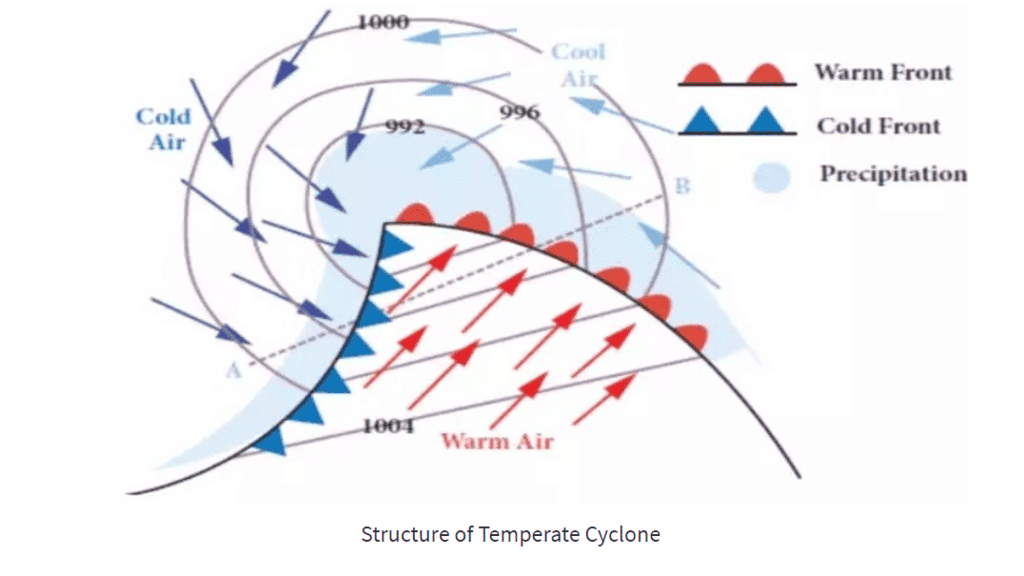
The axis of dilation is pivotal for temperate cyclone formation, driving dynamic weather changes. Understanding its role, as seen in 2024, aids in predicting and mitigating cyclone impacts.
Q2: Describe latitudinal distribution of Köppen’s classification of world climate. (2024)
Ans: Köppen’s classification, based on temperature, precipitation, and vegetation, categorizes world climates into five major groups (A, B, C, D, E), distributed latitudinally due to solar radiation and atmospheric circulation patterns, with relevance in 2024.
- Tropical Climates (A): Found between 0°-20° latitude, these include Af (tropical rainforest, e.g., Amazon), Am (monsoon, e.g., India’s Western Ghats), and Aw (savanna, e.g., East Africa). In 2024, heavy monsoons in India reflected Am characteristics.
- Dry Climates (B): Spanning 20°-35° latitude, these include BWh (hot desert, e.g., Sahara) and BWk (cold desert, e.g., Gobi). In 2024, BWh regions faced intensified heatwaves.
- Temperate Climates (C): Occurring between 35°-60° latitude, these include Csa (Mediterranean, e.g., Southern California) and Cfb (marine west coast, e.g., UK). In 2024, Cfb regions saw increased rainfall.
- Cold Climates (D): Found in 50°-70° latitude, these include Dfb (boreal forest, e.g., Siberia). In 2024, Dfb areas experienced prolonged winters.
- Polar Climates (E): Above 70° latitude, these include ET (tundra, e.g., Arctic) and EF (ice cap, e.g., Antarctica). In 2024, ET regions saw accelerated permafrost melt.
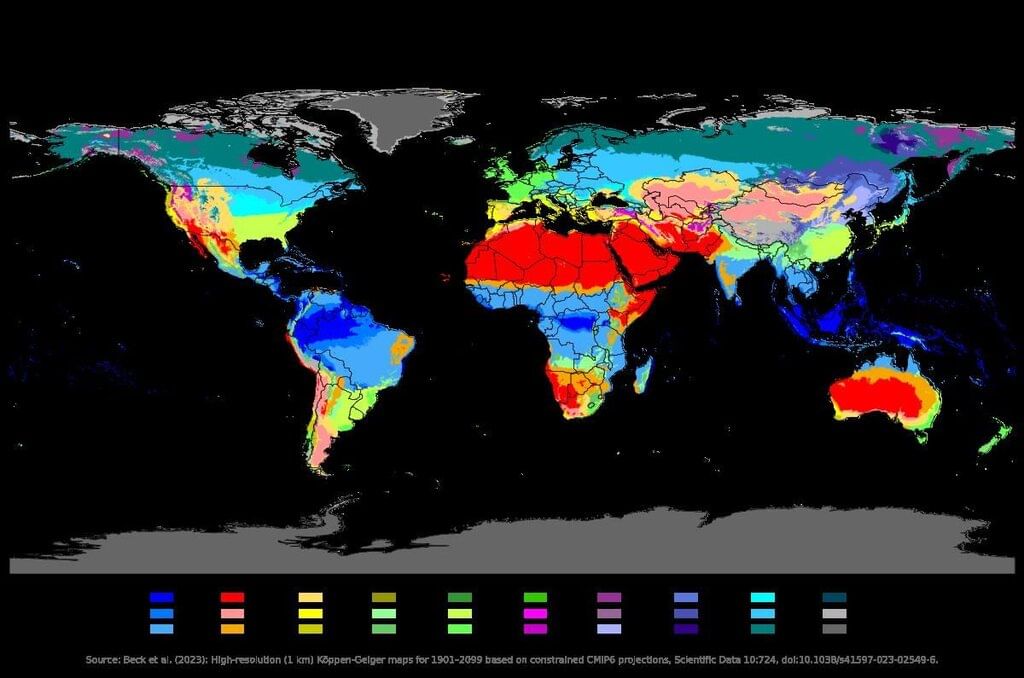
Köppen’s classification highlights latitudinal climate patterns, guiding adaptation strategies in 2024 for agriculture and disaster management.
Q3: Explain air masses and associated weather dynamics. How do air masses influence the weather conditions of the Northern Hemisphere? (2024)
Ans: Air masses, large bodies of air with uniform temperature and humidity, significantly influence weather dynamics in the Northern Hemisphere by interacting with each other and local geography, as observed in 2024.
- Characteristics and Types: Air masses are classified by source regions: maritime (m) or continental (c), and tropical (T), polar (P), or arctic (A). For example, mT air masses from the Gulf of Mexico are warm and moist, while cP air masses from Siberia are cold and dry.
- Weather Dynamics: When air masses meet, they form fronts, causing weather changes. In 2024, a cP air mass over North America clashed with an mT air mass, triggering blizzards in the Midwest.
- Influence on Northern Hemisphere:
- North America: mT air masses from the Atlantic fueled hurricanes in 2024, impacting the southeastern US.
- Europe: cP air masses from Russia brought cold waves to Scandinavia in 2024, while mT air masses caused heavy rainfall in the UK.
- Asia: mT monsoon air masses dominated South Asia, with India experiencing heavy rains in 2024.
- Challenges: Rapid air mass shifts complicate weather forecasting, as seen in 2024’s erratic European weather patterns.
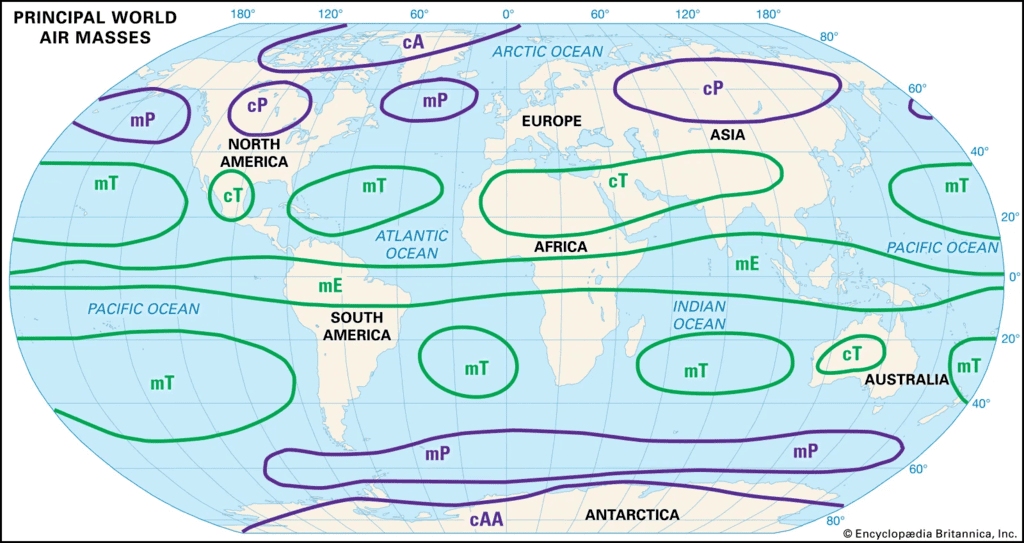
Air masses drive diverse weather phenomena, shaping Northern Hemisphere climates. Advanced forecasting in 2024 enhances preparedness for their impacts.
Q4: Explain the characteristics and weather conditions associated with ‘Anticyclones’ giving suitable examples. (2023)
Ans: Anticyclones are high-pressure systems characterized by sinking air, clear skies, and stable weather, contrasting with cyclones. They significantly influence regional climates, as observed in 2023.
- Characteristics: Anticyclones feature clockwise winds in the Northern Hemisphere, divergent surface flow, and subsiding air, inhibiting cloud formation. They are often large, covering thousands of kilometers.
- Weather Conditions:
- Clear Skies: Sinking air prevents condensation, leading to sunny weather. In 2023, a winter anticyclone over the US Great Plains brought clear, cold days.
- Temperature Extremes: In summer, anticyclones cause heatwaves (e.g., India’s 2023 heatwave), while in winter, they bring cold snaps (e.g., Europe’s 2023 frost).
- Fog and Smog: Stable conditions trap pollutants, causing fog or smog, as seen in Delhi’s 2023 winter pollution spikes.
- Examples: In 2023, a persistent anticyclone over the Azores stabilized Western Europe’s summer weather, boosting tourism, while a Siberian anticyclone caused frigid conditions in East Asia.
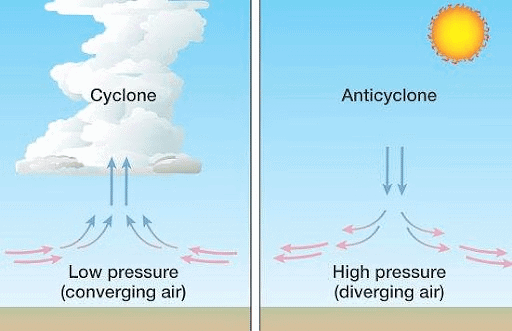
Anticyclones shape seasonal weather patterns, supporting agriculture and tourism but posing challenges like heat stress. In 2023, their predictability aided planning.
Q5: What are the causes of origin of local winds? Discuss their significance on prevailing weather and climate in various regions, with suitable examples. (2023)
Ans: Local winds, driven by regional temperature and pressure differences, significantly influence weather and climate, shaping microclimates and livelihoods, as evident in 2023.
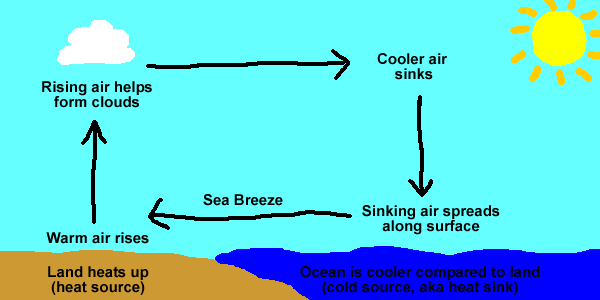
- Causes of Origin:
- Differential Heating: Land and sea heat unevenly, creating breezes. Sea breezes cool coastal areas, as seen in Mumbai’s 2023 summers.
- Topography: Mountains and valleys channel winds, like the Chinook in North America, warming the Rockies in 2023.
- Urban Heat Islands: Cities generate winds due to heat, influencing Delhi’s 2023 microclimate.
- Significance:
- Weather Moderation: Sea breezes reduce coastal heat, benefiting agriculture in Gujarat in 2023.
- Precipitation Patterns: Local winds like the Mistral in France triggered dry conditions in 2023, affecting vineyards.
- Economic Impacts: Winds support activities like fishing in Kerala’s 2023 monsoon season but can disrupt transport.
Local winds enhance regional climate diversity, requiring tailored management for their benefits, as seen in 2023.
Q6: How does inversion of temperature occur? Explain its significance on local weather with suitable examples. (2023)
Ans: Temperature inversion occurs when air temperature increases with altitude, reversing the normal decrease, trapping cooler air below. Its impact on local weather was notable in 2023.
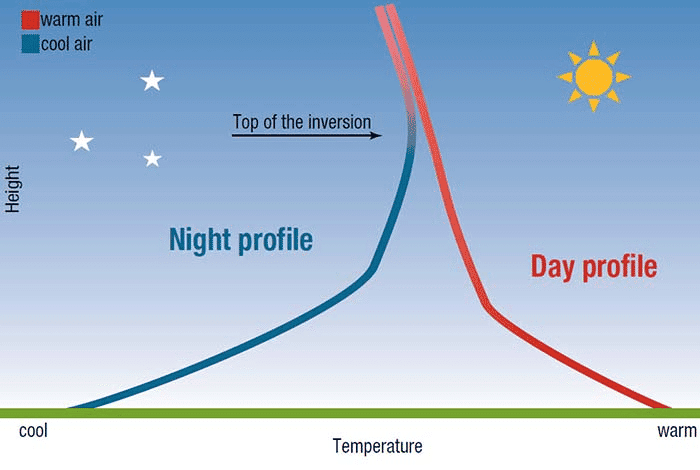
- Formation Mechanisms:
- Radiation Cooling: At night, the ground loses heat, cooling surface air. In 2023, rural Punjab saw inversions during winter nights.
- Advection: Warm air moves over cooler surfaces, as in coastal California’s 2023 inversions.
- Subsidence: Sinking air in anticyclones warms aloft, creating inversions, like in Delhi’s 2023 winters.
- Weather Impacts:
- Fog Formation: Trapped moisture causes fog, reducing visibility, as in London’s 2023 winter fog.
- Air Pollution: Inversions trap pollutants, worsening smog in Beijing in 2023.
- Temperature Stability: Inversions maintain cold or warm conditions, delaying spring in Canada in 2023.
Inversions significantly alter local weather, necessitating monitoring for air quality and transport safety, as seen in 2023.
Q7: What is a pollution dome? Discuss its formation and impacts. (2022)
Ans: A pollution dome is a layer of polluted air trapped over urban areas under specific atmospheric conditions, exacerbating air quality issues. Its formation and impacts were significant in 2022.
- Formation: Pollution domes occur during temperature inversions, where warm air aloft traps cooler, polluted air near the ground. In 2022, Delhi’s winter inversions created pollution domes, worsened by calm winds and high-pressure systems.
- Contributing Factors: Urban emissions from vehicles, industries, and biomass burning, combined with stable anticyclonic conditions, intensify domes. In 2022, stubble burning in Punjab contributed to Delhi’s dome.
- Impacts:
- Health Risks: High PM2.5 levels cause respiratory issues, affecting millions in Delhi in 2022.
- Visibility Reduction: Domes cause dense smog, disrupting transport, as seen in Beijing’s 2022 winter.
- Economic Costs: Reduced productivity and healthcare costs rose in polluted cities in 2022.
Pollution domes highlight the need for emission controls and weather monitoring, as seen in India’s 2022 air quality initiatives.
Q8: With suitable examples describe the impacts of the movement of air masses on weather and winds in different parts of the continents. (2022)
Ans: The movement of air masses, driven by temperature and pressure gradients, significantly shapes weather and wind patterns across continents, as observed in 2022.
- North America: Cold continental polar (cP) air masses from Canada moved south, causing blizzards in the US Midwest in 2022, with strong northerly winds.
- Europe: Maritime tropical (mT) air masses from the Atlantic brought heavy rainfall to the UK in 2022, accompanied by westerly winds, while cold cP air masses from Russia triggered snow in Scandinavia.
- Asia: Monsoonal mT air masses from the Indian Ocean drove heavy rains in India’s 2022 monsoon, with southwesterly winds, while cP air masses from Siberia caused cold waves in China.
- Africa: Tropical continental (cT) air masses over the Sahara intensified dry, dusty Harmattan winds in West Africa in 2022, affecting agriculture.
Air mass movements create diverse weather, requiring region-specific forecasting, as seen in 2022.
Q9: The rise of surface temperature brings severe consequences. Elaborate on the potential changes and threats associated with it in the world. (2022)
Ans: Rising surface temperatures, driven by climate change, pose severe threats to ecosystems, economies, and societies, with significant impacts in 2022.
- Extreme Weather: Heatwaves and storms intensified. In 2022, India’s heatwaves reduced crop yields, while Europe’s floods disrupted infrastructure.
- Ecosystem Disruption: Warming threatens biodiversity. In 2022, coral bleaching in Australia’s Great Barrier Reef accelerated due to ocean warming.
- Health Risks: Higher temperatures increase heatstroke and disease spread. In 2022, dengue cases rose in South Asia due to prolonged warm seasons.
- Economic Impacts: Agriculture and fisheries face losses. In 2022, African droughts cut maize production, raising food prices.
Mitigating temperature rise through renewable energy and adaptation, as seen in 2022 global efforts, is critical for sustainable development.
Q10: Describe how short-term variations in temperature are related to the processes of receiving energy from the sun to the Earth’s surface and dissipating it to the atmosphere. (2022)
Ans: Short-term temperature variations, such as daily or seasonal changes, are driven by the balance of solar energy received and dissipated, influenced by atmospheric and terrestrial processes, as observed in 2022.
- Solar Energy Reception: The Earth’s surface absorbs solar radiation, with intensity varying by latitude, time, and cloud cover. In 2022, clear summer days in India maximized absorption, raising daytime temperatures.
- Energy Dissipation: Heat is lost via radiation, convection, and conduction. At night, radiative cooling lowered temperatures in rural Australia in 2022.
- Atmospheric Influences: Clouds and aerosols reflect or trap heat, affecting variations. In 2022, monsoon clouds in Southeast Asia moderated daytime heat.
- Surface Factors: Land surfaces (e.g., deserts) heat and cool faster than water, causing rapid changes. In 2022, coastal areas like Mumbai had stable temperatures compared to inland Rajasthan.
These processes drive temperature fluctuations, requiring accurate modeling for weather forecasting, as seen in 2022.
|
304 videos|717 docs|259 tests
|
FAQs on Topic wise Previous Year Questions (Solved) : Climatology - Geography Optional for UPSC
| 1. What are the main components of the Earth's climate system that UPSC candidates should focus on for climatology? |  |
| 2. How does the greenhouse effect contribute to climate change, and why is it significant for UPSC aspirants? |  |
| 3. What are the primary factors influencing climate variability, and how can they be classified? |  |
| 4. Why is understanding climatic zones important for UPSC examinations, and what are the major climatic zones of the world? |  |
| 5. What role do climate models play in predicting future climate scenarios, and how are they utilized in policymaking? |  |
















